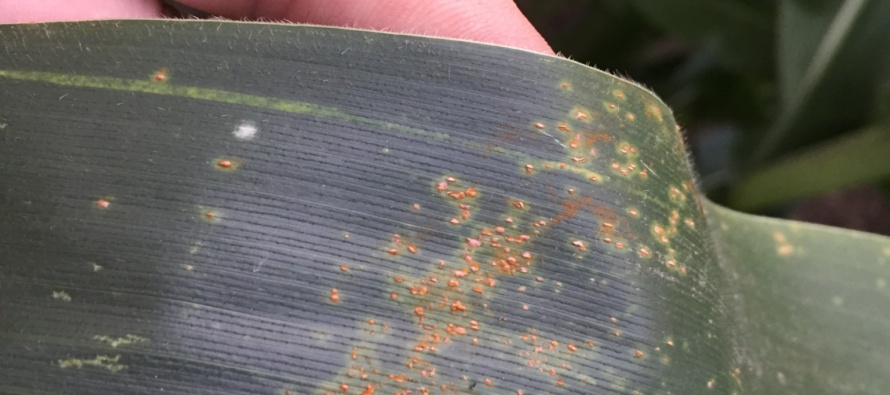Corn Disease Update: July 4, 2016

Related Articles
- 2010 Soybean And Corn Variety Trial Data 3
- Rice Variety Trial Results For 2010, Plus Rice Research Report 0
- Evaluation of Peanut Prescription Rx Program in Mississippi 0
Latest Tweets

Eyespot look-a-likes are rampant in the MS corn production system. Several diseases of no consequence can produce extremely similar symptoms. Disregard them as yield reducers.
Over the past two weeks things have gone from quiet to a little less quiet on the disease front. Few if any diseases have been observed throughout the majority of the corn crop. However, over the past 10 days, additional southern rust has been observed in the state.
Eyespot?
We do not normally see eyespot in MS. In fact, eyespot prefers cool, wet weather. Over the past month I would not claim we have had cool, or wet weather. In addition, the organism survives between seasons in residue remaining between corn crops. Even in situations where continuous corn has been produced in MS for more than five years I have not observed eyespot. Over the past two weeks I have received a few calls concerning the presence of eyespot. In addition to the calls in MS, neighboring states have also observed similar symptoms, predominantly in Arkansas and Louisiana. Small lesions on leaves, brown to tan in coloration with brown to maroon to sometimes red margins have been observed in most situations throughout the corn canopy. The lesions produced throughout MS are a result of either Alternaria leaf spot or Curvularia leaf spot. Both of these diseases are infrequently observed in our production system and are not considered to be threats to corn production. In addition, even in the diagnostic disease books that are available from numerous sources, the two diseases are considered diseases of no consequence and are broadly considered to be diseases of tropical incidence (unlike eyespot).
Southern rust
Over the past 10 to 14 days southern rust has been observed in numerous counties across MS. However, to date (July 5, 2016), southern rust has not been observed in east MS (east of I-55). Even though southern rust has been observed in a substantial number of counties I have not received a call nor have I observed substantial amounts of rust in any single corn field. As corn continues through reproductive growth stages and pushes all nutrition from leaves to developing ears, southern rust will continue to increase and be observed in each corn field and in additional counties.
Based on the level of disease observed in MS, and the general growth stages of the corn crop at the present time, I would suggest that corn at dent growth stages is out of the woods when it comes to southern rust. Two years ago a large-plot fungicide trial was conducted in a field of corn in east MS that had substantial southern rust at the time of application (much more than has been observed in any single field this season in MS). Fungicide application, using a single product, did not result in an economic return in that situation. Base fungicide decisions on protecting yield in situations where corn may produce a high yield this season.

Corn standability is not general impacted by southern rust infection as indicated in this photo 18 days post treatment in a field situation with southern rust infection at the time of fungicide application.
Keep two things in mind when dealing with southern rust: 1) finding southern rust in a corn field does not mean that a field with a hypothetical 200 bushel/Acre potential will go to zero as a result of southern rust and 2) corn will not fall over if the southern rust infection was observed at reproductive growth stages (R1 +). Annually my number one telephone call has to do with corn that could potentially lodge as a result of southern rust infection. Last year trials were conducted in Stoneville to consider the role of fungicide application on southern corn rust at dent. Due to the excessive downy mildew in the field the yield results were confounded. However, observations of southern rust over time suggested several important results of the fungicide applications: 1) regardless of fungicide product, southern rust increased over time following the fungicide application and 2) corn did not lodge as a result of the observation of southern rust at dent (see image at left). People with decades of experience in corn production systems suggest that for southern rust to cause lodging in corn the disease needs to infect the corn plant prior to tassel. Late planted corn that has either recently reached tassel, or has not yet tasseled, should be scouted closely for the presence of southern rust.
To monitor the southern corn rust situation throughout the corn production system follow the web-based map at: http://scr.ipmpipe.org/cgi-bin/sbr/public.cgi
Northern corn leaf blight
I have received few calls regarding NCLB and observed a lot less lesions this year than in years past. I think a lot of that is due to a non-conducive environment. High temperatures and dry conditions are not conducive for a disease such as NCLB. Even in the efficacy trials in Stoneville, which has been in corn production going on seven years in some parts of the field, extremely low levels of NCLB are present. I walked over 400 plots on Monday (June 27, 2016) and likely only observed 20 NCLB lesions in the entire area.





Let me tell You a sad story ! There are no comments yet, but You can be first one to comment this article.
Write a comment